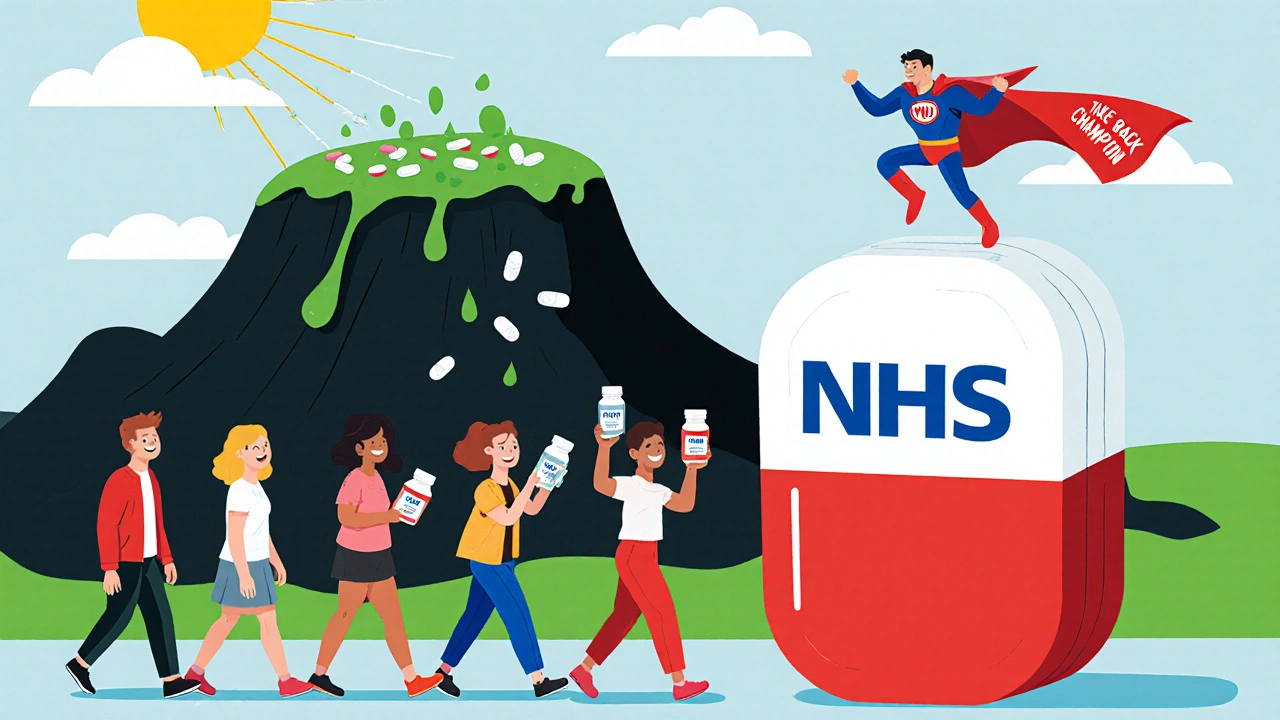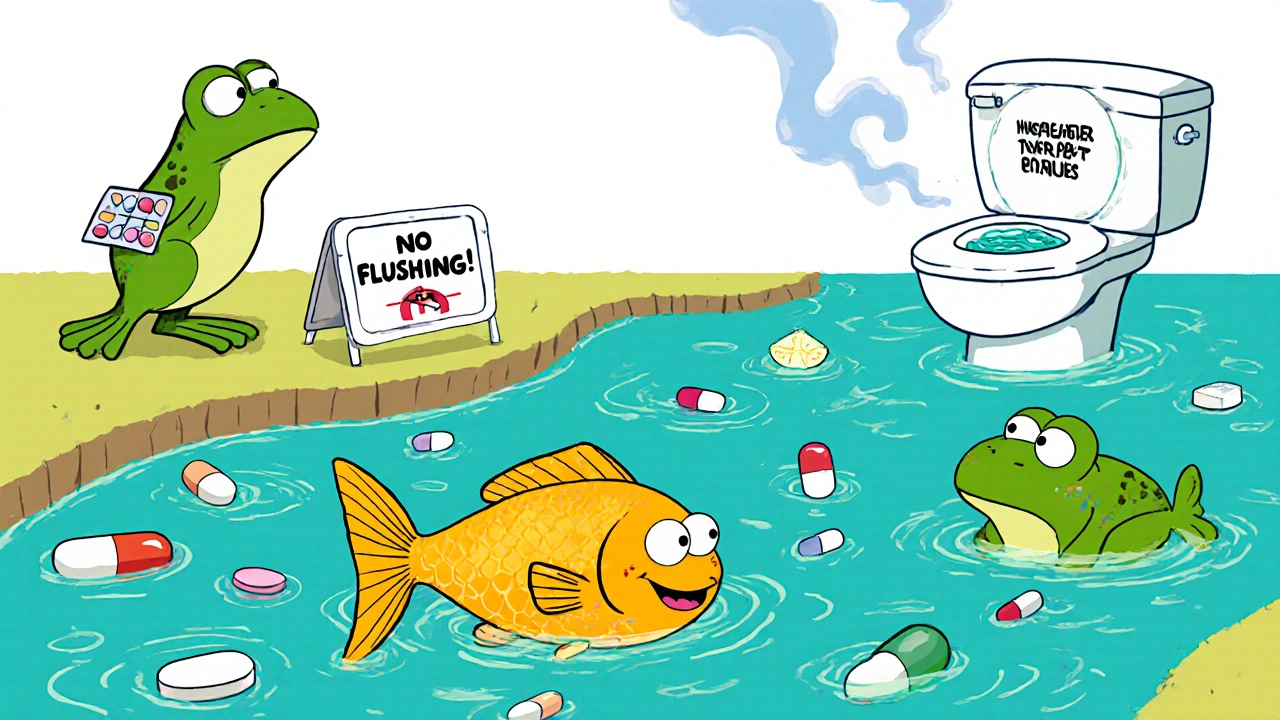Every year, millions of unused or expired pills, patches, and liquids end up in toilets and sinks across the UK and beyond. It’s easy to think: It’s just medicine. It’ll wash away. But that’s not true. Flushing medications doesn’t make them disappear-it sends them straight into rivers, lakes, and even your drinking water. And the damage is already here.
What Happens When You Flush Medication?
When you flush a pill down the toilet, it doesn’t vanish. Wastewater treatment plants aren’t built to remove pharmaceutical chemicals. They’re designed to clean out solids, bacteria, and sewage-not tiny drug molecules. These compounds slip through untouched, entering rivers, groundwater, and eventually, drinking water supplies. Studies show that over 80% of UK and US waterways contain traces of pharmaceuticals. Common drugs like ibuprofen, antidepressants, antibiotics, and birth control hormones have been found in fish, frogs, and even drinking water. In one study, fish downstream from wastewater outflows showed female characteristics because of estrogen-like compounds from birth control pills. Other fish developed abnormal reproductive organs. These aren’t lab experiments-they’re real animals in real rivers. Even small amounts matter. Concentrations are often below 100 nanograms per litre-so low you’d need a microscope to see them. But biological systems don’t need much. Hormones, for example, can trigger changes in aquatic life at levels a thousand times lower than what’s considered safe for humans.Why Flushing Is Only Part of the Problem
Flushing gets all the attention, but it’s not the biggest source of pollution. Most pharmaceuticals enter waterways through human excretion. When you take a pill, your body absorbs only 20-30% of it. The rest leaves your system through urine or feces and ends up in sewage. That’s unavoidable-it’s how medicine works. But improper disposal adds a second, avoidable layer. When people throw pills in the trash instead of using take-back programs, those drugs end up in landfills. Rainwater washes through the waste, creating toxic runoff called leachate. In some landfills, researchers found acetaminophen at levels over 100,000 nanograms per litre-far higher than what’s found in rivers. That leachate can seep into groundwater, contaminating wells and aquifers. So the real issue isn’t just flushing-it’s the entire lifecycle of unused medicine. Stockpiling expired drugs in medicine cabinets, then dumping them carelessly, creates a slow leak into the environment.What Medications Should You Never Flush?
The FDA used to recommend flushing certain medications to prevent accidental poisoning, especially powerful opioids like fentanyl and oxycodone. Their logic: if a child or pet finds a pill in the trash, it could be deadly. Flushing was seen as the safest way to destroy them. But that guidance has changed. In October 2022, the FDA updated its flush list. Only 15 medications still qualify, and they’re all high-risk opioids or sedatives. For everything else-antibiotics, blood pressure pills, painkillers, thyroid meds, antidepressants-flushing is no longer recommended. If you’re unsure whether your medication is on the list, check the FDA’s website or ask your pharmacist. Don’t guess. Flushing anything not on the list adds unnecessary pollution.
Safe Alternatives: What You Should Do Instead
The best way to dispose of unused medications is through a take-back program. These are collection points-often at pharmacies, hospitals, or police stations-where you can drop off old pills, patches, or liquids for safe destruction. In the UK, most pharmacies participate in the NHS take-back scheme. You don’t need a receipt or prescription. Just bring your expired or unwanted meds in their original containers. The pharmacy seals them and sends them to a licensed facility for incineration, which completely destroys the chemicals without releasing them into the environment. If there’s no drop-off nearby, the EPA and UK environmental agencies recommend a two-step home disposal method:- Remove pills from their original packaging. Take off any personal info to protect your privacy.
- Mix them with something unappetizing-used coffee grounds, cat litter, or dirt. Put the mixture in a sealed plastic bag or container.
- Throw it in your regular household trash.
Why Take-Back Programs Still Aren’t Working
You might think: if this is so important, why aren’t more people using take-back programs? The answer is simple: most people don’t know they exist. A 2021 survey found only 30% of UK residents knew where to return unused medications. Even fewer knew they could do it for free. Access is another issue. In rural areas, the nearest drop-off point might be 20 miles away. Many pharmacies don’t have dedicated bins. Some only host collection events once a year. And confusion doesn’t help. The FDA’s old advice to flush certain drugs created lasting misinformation. Many people still think flushing is fine-or even required-for powerful medications. Others believe expired drugs are harmless and can sit in a cabinet for years. The result? Millions of pills sit in drawers, gathering dust, until someone throws them in the trash-or flushes them out of frustration.
What’s Being Done to Fix This?
Change is happening, but slowly. In the EU, 16 countries now require drug manufacturers to pay for take-back programs under Extended Producer Responsibility (EPR) laws. The idea: if companies profit from selling medicine, they should help clean up the waste. In the UK, the NHS has expanded pharmacy take-back services, and some local councils now offer annual medication collection days. Scotland has piloted mail-back envelopes for home disposal-similar to how you return used sharps. Technologically, wastewater treatment is catching up. New filtration systems using activated carbon or ozone can remove up to 95% of pharmaceuticals-but they’re expensive. Retrofitting a single treatment plant can cost over £1 million. That’s why prevention, not cleanup, is the priority. The most promising solution? Education. California passed a law in 2024 requiring pharmacists to give disposal instructions with every prescription. The UK is moving in that direction too. More GPs are now asking patients: “Do you know what to do with your leftover pills?”What You Can Do Today
You don’t need to wait for policy changes to make a difference. Here’s what you can do right now:- Check your medicine cabinet. Look for expired or unused prescriptions. Don’t wait until they’re old-clear them out every six months.
- Find your nearest take-back location. Use the NHS website or call your local pharmacy. Most have drop-off bins.
- If you can’t get to a drop-off, use the coffee grounds method. Seal it. Trash it.
- Don’t flush anything unless it’s on the official FDA list. If you’re unsure, don’t flush.
- Ask your doctor: “Do I really need this much?” Many prescriptions are written for 30 days, but patients only use 10. Request smaller quantities.
Why This Matters Beyond the Environment
This isn’t just about fish or rivers. It’s about public health. Antibiotics in water contribute to drug-resistant superbugs. Hormones in water may affect human development. Even trace amounts, over decades, could have unknown consequences. And there’s a moral angle. We wouldn’t dump paint or pesticides down the drain. Why treat medicine differently? It’s a toxic substance. It deserves proper handling. The good news? The solution is simple: don’t flush. Use take-back. Educate others. It doesn’t require new technology, big laws, or expensive gadgets. Just a change in behavior. Every pill you dispose of properly is one less chemical entering our water. And that’s something we can all control.Is it ever okay to flush medication?
Only if the medication is on the FDA’s official flush list-currently only 15 high-risk opioids like fentanyl and oxycodone. For all other drugs, including antibiotics, painkillers, and antidepressants, flushing is discouraged. Always check the label or ask your pharmacist before flushing anything.
Can I throw medication in the recycling bin?
No. Medications should never go in recycling bins. Recycling facilities aren’t equipped to handle pharmaceutical waste, and mixing drugs with paper or plastic can contaminate entire recycling streams. Always use a take-back program or dispose of them in the trash using the coffee grounds method.
Do expiration dates really matter for disposal?
Yes. Expired medications can lose potency, but they don’t become harmless. Some break down into unknown compounds. Others remain active and can still harm wildlife or contribute to antibiotic resistance. Always treat expired drugs the same as unused ones-take them to a drop-off site or dispose of them safely at home.
Are take-back programs free?
Yes. In the UK, NHS-affiliated pharmacies and many local councils offer free medication take-back services. You don’t need insurance, a receipt, or proof of purchase. Just bring your unused or expired pills in their original containers.
What if there’s no drop-off near me?
If you can’t reach a pharmacy or collection site, mix your pills with used coffee grounds, cat litter, or dirt. Put the mixture in a sealed plastic bag or container, then throw it in your regular household trash. This reduces the risk of misuse and slows environmental contamination. Avoid flushing or pouring down the sink.
Can I flush liquid medications?
No. Liquid medications, including syrups and eye drops, should never be flushed. They dissolve easily and enter waterways faster than pills. For liquids, mix them with an absorbent material like sawdust or paper towels, seal them in a container, and dispose of them in the trash. Always check with your pharmacist for specific guidance.
 Nov, 20 2025
Nov, 20 2025

Willie Doherty
November 22, 2025 AT 13:15The presence of pharmaceutical residues in aquatic ecosystems represents a non-trivial ecotoxicological burden, particularly given the chronic low-dose exposure profiles experienced by biota. Studies indicate endocrine disruption at concentrations as low as 1 ng/L, far below human therapeutic thresholds. The persistence of compounds like carbamazepine and venlafaxine in groundwater warrants immediate regulatory re-evaluation of current disposal paradigms.
Wastewater treatment infrastructure remains fundamentally inadequate for micropollutant removal. Advanced oxidation processes and activated carbon filtration show promise but are cost-prohibitive at scale. Prevention through take-back programs remains the only viable strategy.
The FDA’s revised flush list is a step in the right direction, though public awareness remains critically low. Education must be institutionalized-not left to voluntary pharmacist outreach.
Extended Producer Responsibility (EPR) models, as implemented in the EU, should be adopted universally. Pharmaceutical corporations must internalize the externalized environmental costs of their products.
It is not sufficient to merely advise against flushing. Structural change is required: mandatory disposal instructions at point of sale, standardized collection infrastructure, and public funding for retrofitted treatment facilities.
The moral equivalence between pharmaceutical waste and hazardous chemical waste is undeniable. We do not pour paint thinner down the drain. Why do we tolerate this with prescription drugs?
Until systemic accountability is enforced, we are merely performing symbolic acts of environmental virtue while the contamination continues unabated.
Cooper Long
November 22, 2025 AT 15:05Flushing meds is a relic of bad policy. The FDA update was long overdue. But the real problem isn't people flushing-it's that we're prescribed way too much in the first place.
Pharmaceutical companies push volume. Doctors follow protocols. Patients hoard pills out of fear they'll need them again. It's a cycle.
Take-back programs are great but useless if you live in rural Idaho or rural Wales. No one's going to drive 40 miles to drop off a bottle of expired ibuprofen.
What we need is mandatory prescription limits at point of sale. No more 30-day scripts for painkillers if you're only going to use 5 pills.
And stop calling it 'disposal.' It's waste management. We need to treat it like the hazardous material it is.
Simple. No fluff. No hashtags. Just policy that matches reality.